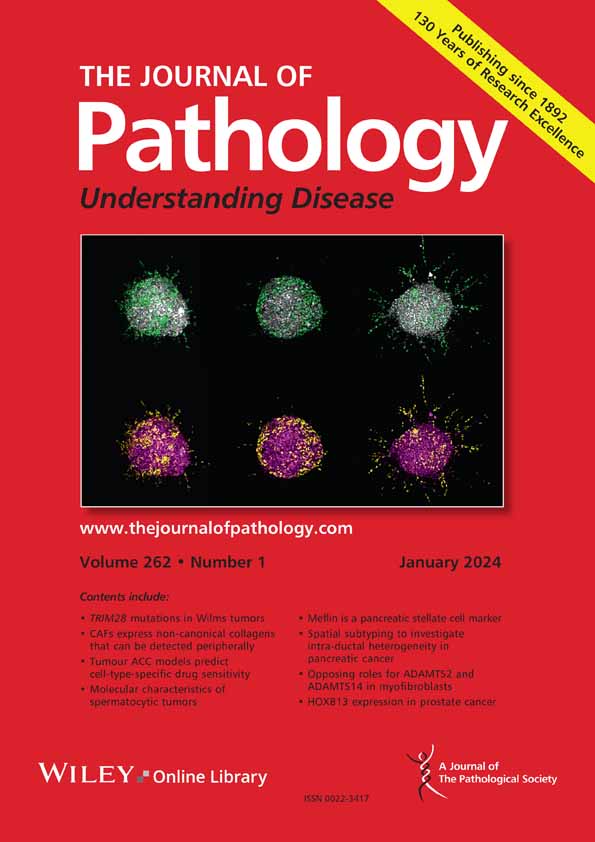Joachim T Siaw, Peter Merseburger, Marcus Borenäs, Caroline Jansson, Jenny Karlsson, Arne Claeys, Eva Jennische, Dan E Lind, David Gisselsson Nord, Ruth H Palmer, Jimmy Van den Eynden
下载PDF
{"title":"对存档的FFPE样本中原发性神经母细胞瘤微环境的空间转录组学探索揭示了新的旁分泌相互作用。","authors":"Joachim T Siaw, Peter Merseburger, Marcus Borenäs, Caroline Jansson, Jenny Karlsson, Arne Claeys, Eva Jennische, Dan E Lind, David Gisselsson Nord, Ruth H Palmer, Jimmy Van den Eynden","doi":"10.1002/path.6457","DOIUrl":null,"url":null,"abstract":"<p>High-risk neuroblastomas exhibit a high degree of intratumoral heterogeneity. Single-cell RNA sequencing has greatly improved our understanding of these tumors, but the method lacks cellular tissue context and spatial information about local signaling dynamics. To address this, we profiled untreated and chemotherapy-treated high-risk neuroblastomas from archived, formalin-fixed, paraffin-embedded (FFPE) tissues from two patients using spatial transcriptomics. We confirmed the transcriptional and cellular heterogeneous nature of the neuroblastoma microenvironment and identified several unique spatial niches and patterns. In one of the treated tumors, a spatially constrained cluster of undifferentiated and 11p-gained cancer cells was identified, surrounded by a rim of macrophages. A signaling interaction between the chemokine <i>CCL18</i> and its receptor <i>PITPNM3</i> was predicted between these cells. In the other tumor, we identified a stromal cluster with high transcriptional similarity to the adrenal cortex. These adrenocortical-like cells expressed several oncogenic ligand-encoding genes (e.g. <i>ALKAL2</i> and <i>NRTN</i>), which were predicted to communicate with neighboring cancer cells that expressed the corresponding receptors (e.g. <i>ALK</i>, <i>RET</i>). Several of these interactions were further validated experimentally and were shown to be clinically relevant. Collectively, our spatial analysis identifies multiple previously unrecognized signaling axes that may offer novel therapeutic options in neuroblastoma. © 2025 The Author(s). <i>The Journal of Pathology</i> published by John Wiley & Sons Ltd on behalf of The Pathological Society of Great Britain and Ireland.</p>","PeriodicalId":232,"journal":{"name":"The Journal of Pathology","volume":"267 2","pages":"181-195"},"PeriodicalIF":5.2000,"publicationDate":"2025-08-08","publicationTypes":"Journal Article","fieldsOfStudy":null,"isOpenAccess":false,"openAccessPdf":"https://www.ncbi.nlm.nih.gov/pmc/articles/PMC12438011/pdf/","citationCount":"0","resultStr":"{\"title\":\"Spatial transcriptomics exploration of the primary neuroblastoma microenvironment in archived FFPE samples unveils novel paracrine interactions\",\"authors\":\"Joachim T Siaw, Peter Merseburger, Marcus Borenäs, Caroline Jansson, Jenny Karlsson, Arne Claeys, Eva Jennische, Dan E Lind, David Gisselsson Nord, Ruth H Palmer, Jimmy Van den Eynden\",\"doi\":\"10.1002/path.6457\",\"DOIUrl\":null,\"url\":null,\"abstract\":\"<p>High-risk neuroblastomas exhibit a high degree of intratumoral heterogeneity. Single-cell RNA sequencing has greatly improved our understanding of these tumors, but the method lacks cellular tissue context and spatial information about local signaling dynamics. To address this, we profiled untreated and chemotherapy-treated high-risk neuroblastomas from archived, formalin-fixed, paraffin-embedded (FFPE) tissues from two patients using spatial transcriptomics. We confirmed the transcriptional and cellular heterogeneous nature of the neuroblastoma microenvironment and identified several unique spatial niches and patterns. In one of the treated tumors, a spatially constrained cluster of undifferentiated and 11p-gained cancer cells was identified, surrounded by a rim of macrophages. A signaling interaction between the chemokine <i>CCL18</i> and its receptor <i>PITPNM3</i> was predicted between these cells. In the other tumor, we identified a stromal cluster with high transcriptional similarity to the adrenal cortex. These adrenocortical-like cells expressed several oncogenic ligand-encoding genes (e.g. <i>ALKAL2</i> and <i>NRTN</i>), which were predicted to communicate with neighboring cancer cells that expressed the corresponding receptors (e.g. <i>ALK</i>, <i>RET</i>). Several of these interactions were further validated experimentally and were shown to be clinically relevant. Collectively, our spatial analysis identifies multiple previously unrecognized signaling axes that may offer novel therapeutic options in neuroblastoma. © 2025 The Author(s). <i>The Journal of Pathology</i> published by John Wiley & Sons Ltd on behalf of The Pathological Society of Great Britain and Ireland.</p>\",\"PeriodicalId\":232,\"journal\":{\"name\":\"The Journal of Pathology\",\"volume\":\"267 2\",\"pages\":\"181-195\"},\"PeriodicalIF\":5.2000,\"publicationDate\":\"2025-08-08\",\"publicationTypes\":\"Journal Article\",\"fieldsOfStudy\":null,\"isOpenAccess\":false,\"openAccessPdf\":\"https://www.ncbi.nlm.nih.gov/pmc/articles/PMC12438011/pdf/\",\"citationCount\":\"0\",\"resultStr\":null,\"platform\":\"Semanticscholar\",\"paperid\":null,\"PeriodicalName\":\"The Journal of Pathology\",\"FirstCategoryId\":\"3\",\"ListUrlMain\":\"https://pathsocjournals.onlinelibrary.wiley.com/doi/10.1002/path.6457\",\"RegionNum\":2,\"RegionCategory\":\"医学\",\"ArticlePicture\":[],\"TitleCN\":null,\"AbstractTextCN\":null,\"PMCID\":null,\"EPubDate\":\"\",\"PubModel\":\"\",\"JCR\":\"Q1\",\"JCRName\":\"ONCOLOGY\",\"Score\":null,\"Total\":0}","platform":"Semanticscholar","paperid":null,"PeriodicalName":"The Journal of Pathology","FirstCategoryId":"3","ListUrlMain":"https://pathsocjournals.onlinelibrary.wiley.com/doi/10.1002/path.6457","RegionNum":2,"RegionCategory":"医学","ArticlePicture":[],"TitleCN":null,"AbstractTextCN":null,"PMCID":null,"EPubDate":"","PubModel":"","JCR":"Q1","JCRName":"ONCOLOGY","Score":null,"Total":0}
引用次数: 0
引用
批量引用





 求助内容:
求助内容: 应助结果提醒方式:
应助结果提醒方式:


